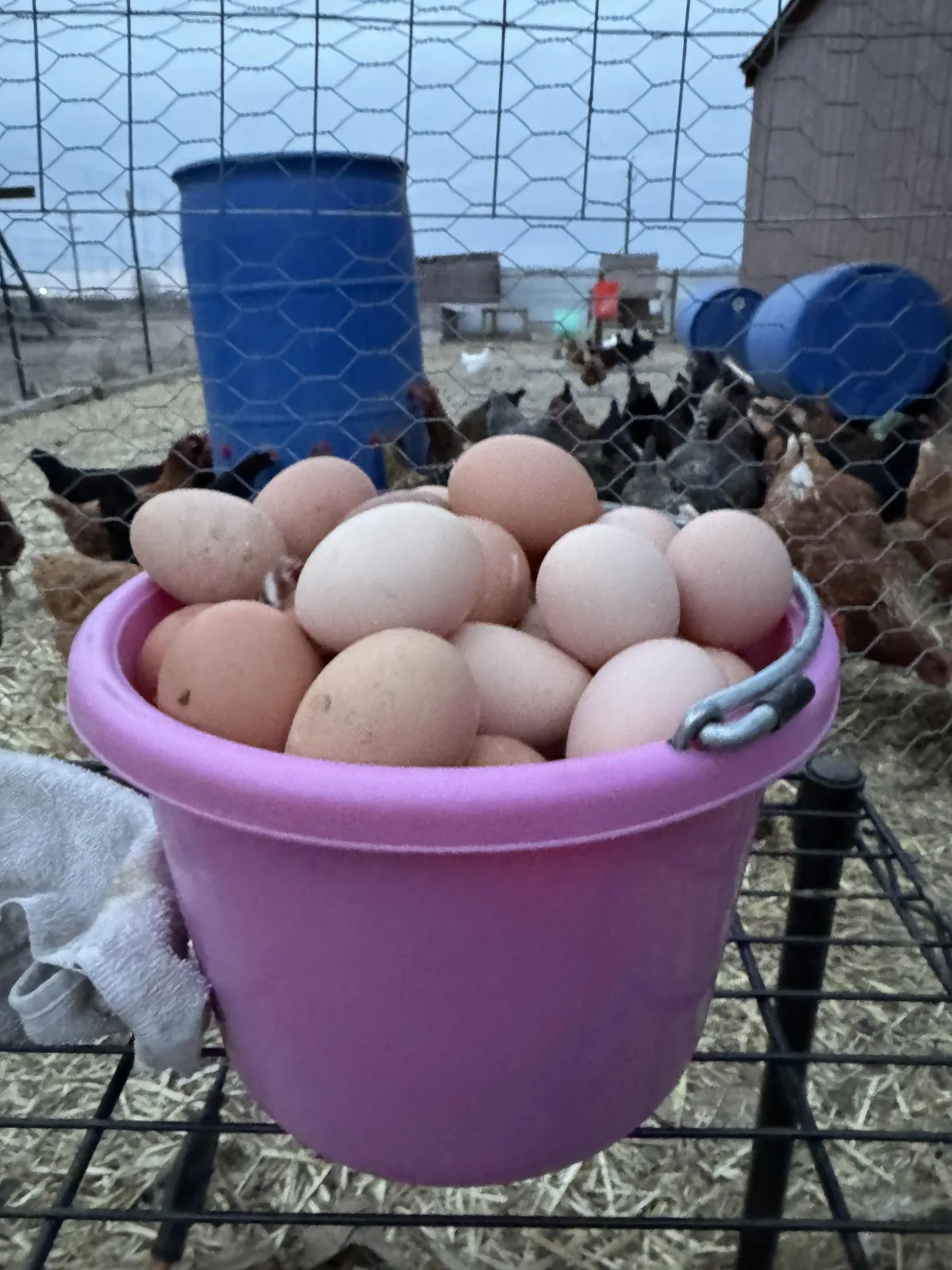
From Four to Thirty: The Relentless Pursuit of a Dozen Eggs a Day
I started with four hens. Four.
It felt like a manageable number and a nice little experiment in backyard chicken keeping. I wasn't trying to feed the whole neighborhood; I just wanted a few fresh eggs for breakfast.
The first few weeks went about as expected. The birds settled in, scratched at the ground, and did their usual chicken things. Then, finally, the eggs started coming.
Initially, the thrill of egg collection was unparalleled. The first warm egg in my palm felt like a tiny miracle—the result of feed, water, time, and nature doing its quiet, steady work.
Then I hit my first wall.
However, the reality was different. Four hens meant four eggs a day at most—but in reality, I was averaging two, maybe three eggs per day. Some days, one of the hens would take a break. On other days, two would sit in the nest box all day as if contemplating some existential crisis and producing nothing.
It became clear that four hens weren't enough. It was time to make a decision.
Scaling Up: From Hobbyist to Egg Hustler
So, I added two more. Six hens felt like a real flock, and for a while, it worked. Most days, I collected four or five eggs—enough for breakfast, maybe an extra half-dozen to give away or stockpile in the fridge.
But then the realization hit.
People wanted eggs.
Family, friends, neighbors—everyone was asking, "Hey, you got extra eggs?" And I loved saying yes. I cherished the moments of handing over a carton of warm, just-laid eggs and seeing people's faces light up at the sight of those deep orange yolks. It was a small act, but it fostered a sense of community and shared joy.
And, if I'm being honest, I relished the feeling of having extra eggs. It was a tangible sign of my success, a symbol of abundance. Having more than enough was a feeling I had never experienced before in my backyard farming journey.
Six hens weren't cutting it anymore.
So I did what any reasonable person would do.
I tripled my flock.
Thirty Birds Later…
The day I brought home enough chickens to hit thirty, I knew I had crossed some kind of invisible line.
Four hens? That was a hobby.
Six? A small backyard flock.
Thirty? That was a lifestyle choice.
I had transitioned from "casual egg collector" to full-fledged chicken pimp.
I had multiple breeds—Leghorns for high production, Orpingtons for their steady consistency, and a few fancier breeds just because I liked how they looked.
And finally, finally, I was getting my dozen eggs a day.
On good days, I was pulling in fifteen, sometimes eighteen. Even on slower days, there were enough to fill a carton.
It was working.
I was selling eggs, trading eggs, and eating more omelets than I ever thought possible.
But then, like clockwork, the universe decided to teach me another lesson.
The Seasonal Slap in the Face
Summer rolled in, and production dipped. The heat made the hens sluggish, and suddenly, instead of a dozen eggs, I was getting eight, sometimes six.
Then came molting season, and the coop looked like a chicken exploded inside it—feathers everywhere, but not an egg in sight.
Winter arrived, and egg production dropped again. The days were shorter, the light was weaker, and I had a choice—do I add artificial light to keep production up or let nature take its course?
I opted for the latter.
And just like that, my "dozen a day" dream was seasonal. It was a lesson I hadn't expected, a reminder that egg production isn't a straightforward equation. Some months, I had more than enough. Others, I had barely half of what I wanted. It was a rollercoaster of surprises and learning experiences.
Some months, I had more than enough. Others, I had barely half of what I wanted.
The Real Answer to 'How Many Chickens Do You Need?'
Here's the thing.
If you ask a beginner, they'll say twelve hens = twelve eggs a day because that's the math.
If you ask someone who's been in the game a little while, they'll tell you twelve hens will get you close, but not quite.
If you ask someone like me, who went from four to thirty birds, they'll tell you the truth:
Egg production isn't math. It's an unpredictable, ever-changing cycle of biology, weather, and sheer poultry attitude.
Some days, you get your dozen. Some days, you don't.
From Four to Thirty: The Relentless Pursuit of a Dozen Eggs a Day
A Journey of Growth, Obsession, and More Eggs Than I Knew What to Do With
It started with four.
I had done my homework, not because I didn't know how chickens laid eggs. I knew a hen wouldn't lay every day, and I'd be lucky to get 5-6 eggs a week from a good layer. I wasn't expecting miracles.
Four hens seemed like a reasonable, controlled way to dip my toes into the world of backyard egg production. A few eggs a day, enough for breakfast, maybe an extra here or there. It felt… manageable.
I set up a small, cozy coop in the backyard, just big enough for them to roost comfortably. I made sure they had high-quality feed, fresh water, and a clean place to lay. And I watched them—every morning and every evening—waiting for that first egg.
And then, one morning, there it was.
Small, warm, tucked into a pile of straw.
The first egg.
I held it in my hand like a treasure. Because it was.
It's hard to explain the feeling to someone who's never raised chickens. There's something about holding an egg from your flock that changes you. It's like proof of life, a little miracle delivered daily.
But that first egg wasn't the real moment of transformation.
That came later when I realized that four hens weren't enough.
The First Expansion: Six Hens
For a while, four hens gave me just enough eggs. Most days, I'd get two or three. Some mornings, I'd get lucky with four. But then came the slow days—days where I'd only get one, or none at all.
I knew it wasn't because they weren't healthy. Chickens just don't lay on command.
And that's when I started to feel the lack.
I had gotten used to cooking with farm-fresh eggs—the deep orange yolks, the richness and satisfaction of knowing they came from my flock. Now, on the off days when I didn't have enough, I felt robbed.
I wasn't about to buy store-bought eggs again. That felt like admitting defeat.
So I did what any rational chicken keeper would do.
I bought two more hens.
Now, with six birds, my production increased. I was averaging four to five eggs a day, which meant I almost always had extra. I started sharing eggs with friends, offering them up in mismatched cartons, feeling a quiet sense of pride every time I handed over a half-dozen.
But something happened.
People wanted more eggs.
Family, neighbors, coworkers—they all loved fresh eggs, and suddenly, my little surplus didn't feel like enough anymore.
I realized something else, too: I liked giving eggs away.
There was something deeply satisfying about providing food from my own backyard. About seeing people light up when they cracked open an egg and saw the difference between my birds' eggs and the pale, anemic yolks from the grocery store.
And that's when it hit me.
I needed more chickens.
The Jump to Thirty: When Things Got Serious
Buying two more hens had felt like a reasonable upgrade. A small, logical step.
Buying twenty-four more? That was… something else entirely.
By this point, I wasn't just adding to my flock—I was building an operation.
I expanded my coop. Reinforced my run. Upgraded my feeders and waterers. What had started as a simple backyard project was now a full-scale commitment.
And let me tell you—thirty chickens is a different world than four.
The first thing I learned? They have politics.
With a smaller flock, pecking order disputes were minor. But with thirty birds, it was like a barnyard version of Game of Thrones. The boss hens made sure everyone knew their place. Some were aggressive, pecking at the lower-ranking birds. Others were sneaky, stealing food whenever they had the chance.
Managing a larger flock meant watching for fights, keeping an eye on injuries, and making sure everyone had enough space.
But the biggest change? The sheer volume of eggs.
When all thirty hens were laying at full production, I was collecting 20-25 eggs a day.
I had gone from not having enough eggs to drowning in them.
And yet…
It still wasn't always predictable.
The Hard Lessons of Large-Scale Egg Production
With more chickens came more challenges.
1. The Summer Slump
Egg production peaks in spring, when daylight hours are long and temperatures are mild. But as soon as the summer heat hit, my numbers dropped.
Some days, instead of collecting two dozen eggs, I was getting ten.
The hens were hot. They weren't eating as much. They spent more time panting in the shade than laying eggs.
I installed fans in the coop, made sure they had plenty of cool water, and started feeding frozen treats to help keep their body temperature down.
But even with all that, egg production never fully recovered until fall.
2. The Molt That Took Half My Eggs
Molting season hit harder than I expected.
One day, the coop looked normal.
The next? Feathers everywhere.
It looked like a massacre had taken place, but really, it was just my hens shedding their old feathers to grow in fresh new ones.
And when they're molting? They don't lay.
For weeks, production slowed to a crawl. A dozen eggs a day? Forget it—I was lucky to get six or seven.
3. The Winter Drought
Egg laying depends on light. When the days get shorter, the hens naturally produce less.
Some people add artificial lighting to keep egg production going. I thought about it, but ultimately decided to let nature take its course.
And so, my egg count dropped again in the dead of winter.
Some mornings, I'd go out to the coop and find only four or five eggs.
It felt like I was back to where I started.
The Real Answer: How Many Chickens Do You Need for a Dozen Eggs a Day?
After everything I'd been through—starting with four, jumping to six, then landing on thirty—I finally understood the realanswer.
It's not just about the numbers.
If you really need a dozen eggs every single day, you need at least 15-20 hens, because:
Some will take random days off.
Some will slow down in heat.
Some will stop completely in molting season.
Some will lay less in winter.
And if you want a guaranteed dozen eggs every day, even in the slow months? You need 20-25 hens to account for fluctuations.
But let me tell you this—once: yout stop.
You once you start'll start with four.
Then six.
Then thirty.
Because at the end of the day, chickens aren't just about eggs.
They're about rhythm, patience, and the joy of watching life unfold in your own backyard.
And that? That's worth more than a dozen eggs a day.
